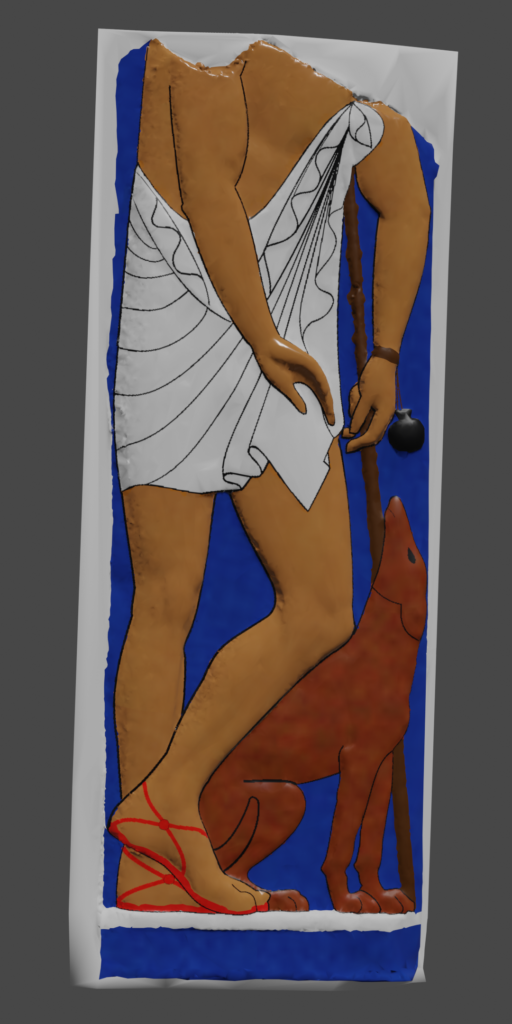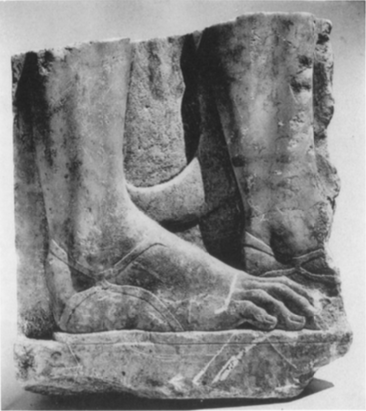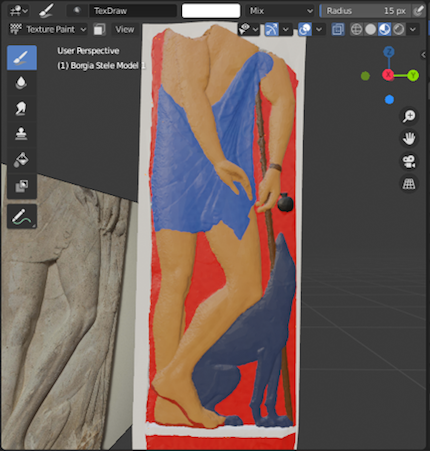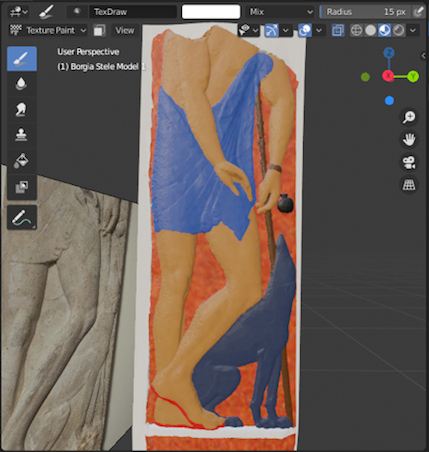
Reconstructing the colors on the Borgia stele was done through comparisons to other painted stelai from a similar time period.
The Borgia stele belongs to a group of stelai known as the “man-and-dog” type. Other well-known examples of this type of funerary stele are Alxenor stele and the Anaxandros stele. Another stele of this man-and-dog type from the Athenian Agora, called Fragment of Archaic Gravestone, Man and Dog (S 1276), preserves traces of paint and provides insight into the colorful nature of these grave stelai. In her catalogue of Archaic sculpture from the Athenian Agora, Evelyn Harrison includes a description of the paint and surface finish on the fragmented stele:
“The man’s flesh is polished; the background and the dog’s tail have a mat finish. The straps of the sandal that pass behind the heel and join the sole at the sides are delicately carved in low relief, but the front strap which passed between the toes and its forked joining to the side straps were left to be shown in paint only. There are traces of red color on the carved straps. … No trace of color remains on the background between the legs” (Harrison 1965:46).
This description highlights the color and surface finishing of these types of stelai and provided comparanda for our reconstruction of the Borgia stele. The coloring of the man’s sandals was based on this specific description; I chose to paint them in red madder lake.


While not of the man-and-dog type, I drew on comparisons from other stelai, such as the Lyseas stele, which has been preserved with its full paint. In addition, it is roughly contemporaneous with the Borgia stele, c. 500 BCE. (Athens, NM 30) Its reconstruction from the early 20th century served as a guide for highlighting the folds and outlines on the Borgia stele. Grapeseed black was used for the reconstruction of the outlines.
A chlamys is a Greek style of clothing for men consisting of a rectangular piece of cloth, fastened over the right shoulder by a pin or fibula. It was worn by hunters, soldiers, and riders. In art, the chlamys could have a wide range of meanings, depending on the color, decorations, and quality (Kazhdan and Ševčenko).
Following the color scheme of the man’s garments on the Lyseas stele, lead white was chosen for the chlamys on the Borgia stele. The man in the Lyseas stele carries a dark-colored kantharos, so I made the aryballos (oil flask) on the Borgia stele grapeseed black.
A 1886 reconstruction of the Borgia stele by Ludvig Fenger depicts the man in a purple chlamys against with a white background (Brøns 2019, 313). While this reconstruction is interesting, I believe it has some probable inaccuracies, most notably the white background. Traces of color in the form of a “red line” on the profile of the stele have been documented during a recent restoration of the Borgia stele, but it is unclear whether these are markings from a previous restoration (Giacobello 2013a).

The dog
When reconstructing the details of the dog on the Borgia stele, I referenced images of dogs from Greek vases. Animals on vases are usually depicted as the same color as the rest of the figures, but the colors of Greek vases are stylized differently than the colors on Greek statuary (Petrakova 2015). I experimented with painting the dog in brown or blue-grey. In the end, I decided to contrast the dog with the blue background, and painted it reddish brown, using 100% opacity red ochre under 60% opacity brown ochre.

Background color: Classical or Archaic?
The background of the Borgia stele would have been painted, which was the norm in all Greek art (Brinkmann 2008, 25). The use of a contrasting background would have increased visibility and made details stand out (Brinkmann 2008, 28). A blue background is the norm for Classical Greek art, while a red background is characteristic of Archaic art (Brinkmann 2008, 25). The Borgia stele’s exact date is unknown, but likely dates from the late 6th century or early 5th century BCE, at the transition between the Archaic and Classical styles. Its background could be either blue or red. I created various color schemes and combinations for the stele’s polychromy reconstruction but in the end settled on the Classical-era blue background. This background was painted entirely in Egyptian blue.
In two early versions of the reconstruction, I played with different pigments including using a red madder lake background and a red ochre background respectively, and experimented with an Egyptian blue chlamys and a grey dog.
Skin color
Artistic conventions in Greek art depict men with darker skin and women with light or white skin. Darker complexions were associated with the masculine ideal of heroes and athletes, while fair-skin was associated with the feminine ideal of being privileged enough not to work outside.
The skin color on my reconstruction of Borgia stele was based on various reconstructions of male statues and sculptures, like the Greek warriors on the Alexander Sarcophagus (Koch-Brinkman et al. 2014, 143). There is some evidence that Egyptian blue was used to lend coolness to painted skin (Verri et al. 2010, 43), so to make the skin color, I layered (from bottom to top):
- Egyptian blue 10% opacity
- Yellow ochre 50% opacity
- Red madder lake 30% opacity
- Brown ochre 30% opacity
Although layering colors on a 3D model achieves a different effect than mixing pigments, my approach was an attempt to create a more realistic skin tone than simply color-picking from the full spectrum available in painting programs.
Other details
The man’s staff and wrist strap are both colored in solid brown ochre.
Many reconstructions include elaborate patterns on the figures’ clothing. I chose not to do this because of technology and time restrictions.

